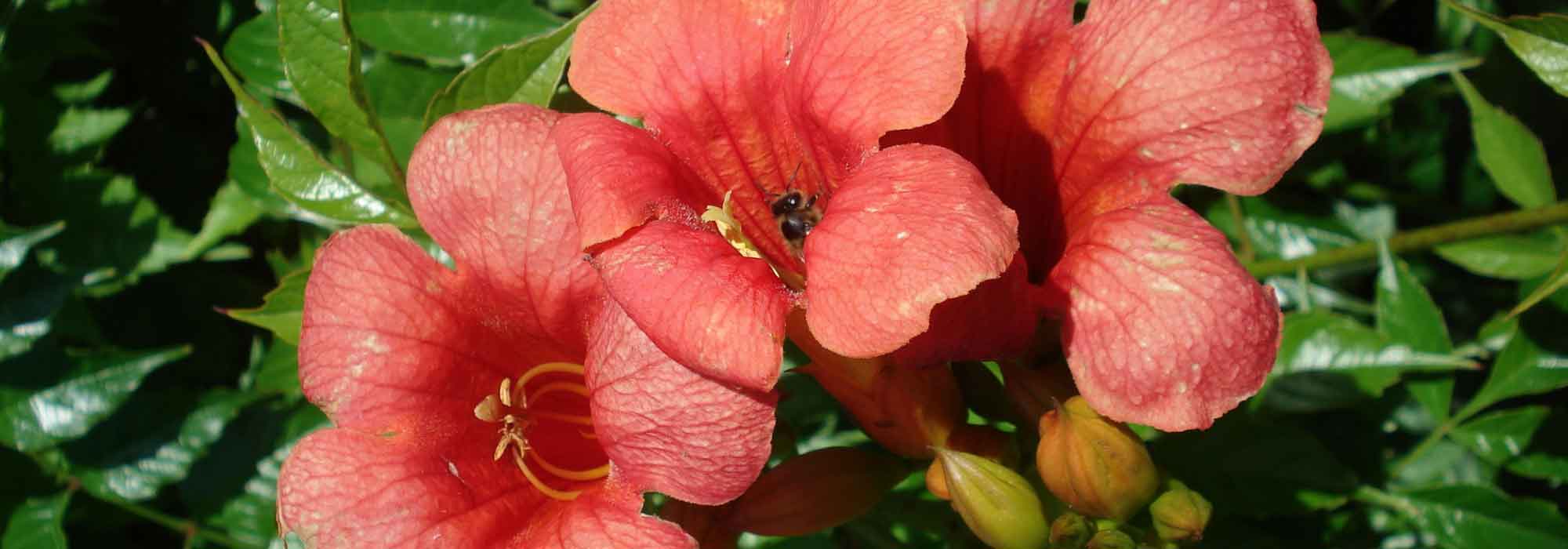
Bignonia: planting, pruning, propagating
Contents
Campsis in a nutshell
- Bignonia is a climbing plant that flowers from May to October
- Its trumpet-shaped flowers, orange, yellow or red, have an exotic charm
- Like ivy, it is a vigorous liana that clings on its own
- Not demanding, it is easy to grow in a mild climate
- It is only sensitive to severe frosts
A word from our expert
Less capricious than a clematis, as voluble as a wisteria, the Trumpet vine or Campsis , sometimes referred to as “Jericho Trumpet“, is a vigorous and original climbing plant. In the garden, it is appreciated for its exuberant bright orange flowering throughout the summer and its lovely foliage that remains semi-evergreen in the mild winter. The spectacle is magical from June to September-October!
Generous, the Trumpet vine can quickly reach a height of up to 8 to 10 m when mature.
Usually orange-red in colour, the flowers of the Trumpet vine display shades of salmon-orange in new cultivars like ‘Indian Summer’, or bright red in ‘Stromboli’, creating a stunning effect in any garden.
Full of energy, its stems cling on their own to anything within reach, transforming even the slightest support into a lush tableau in no time. It is ideal for dressing walls, pergolas, and fences or climbing up a tree.
This voluble liana with exotic looks is easy to grow in mild climates or by the seaside, although it can withstand short periods of frost, down to -10°C on average, and sometimes even more if it is south-facing and mulched in winter.
It adapts to all soils that are not too dry and requires very little maintenance, fearing only severe frosts.
From cuttings to pruning the Trumpet vine, discover this beautiful climbing flower that captivates with its originality and floribundity!
Description and botany
Botanical data
- Latin name Campsis
- Family Bignoniaceae
- Common name Trumpet vine, Trumpet of Jericho
- Flowering from May to autumn
- Height 2 to 10 m
- Exposure Sun, partial shade
- Soil type All, well-drained
- Hardiness -10°C to -15°C depending on varieties
The Trumpet vine or Campsis, known as the “Trumpet of Jericho” from the Bignoniaceae family, comprises vigorous climbing plants native to the forests of the warm and dry regions of the southeastern United States, China, and North America.
Previously classified under the genus Bignonia, it now belongs to the genus Campsis, which includes about 120 genera and 725 species. The genus Bignonia now contains only one species, Bignonia capreolata.
Among the most common species in our gardens are Campsis grandiflora, the large-flowered trumpet vine with its wide, flared trumpet-shaped flowers in a very bright orange-red, but which offers few climbing roots, Campsis radicans, the common trumpet vine or Virginia trumpet vine or “Trumpet jasmine” (another of its nicknames) which clings very easily, Bignonia capreolata, also known as the trumpet vine with tendrils, featuring long fragrant trumpets, Campsis (x) tagliabuana, a cross between Campsis radicans and Campsis grandiflora, and the pink trumpet vine (Podranea ricasoliana), a large sarmentous bush suitable for training, native to South Africa and Zimbabwe.
Many varieties and hybrids have been developed, such as Campsis radicans ‘Indian Summer’, a very hardy Campsis.
The trumpet vine is a woody climbing liana with a rapid to explosive growth (1 m per year) that can form a beautiful bush 8 to 10 m high in all directions in just a few years, sometimes more. This vigorous climber forms aerial roots to anchor itself to its supports. Depending on the species, the plant clings more or less easily, using its vigorous sarmentous stems equipped with branched tendrils that adhere to surfaces like powerful climbing roots, similar to ivy.
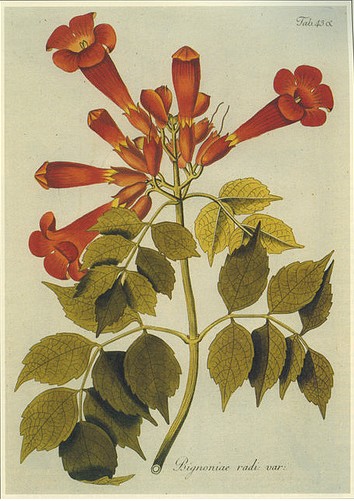
Campsis radicans – botanical illustration
Its deciduous or evergreen foliage in not too cool climates, abundant, adds a certain lushness to the plant and highlights the exotic colours and voluptuous shapes of the flowers. Carried by stiff stems, it consists of opposite leaves sometimes up to 25 cm long, pinnate, oblong to lanceolate, finely divided into dentate or crenate leaflets. In most cases, the two upper leaves end in fine tendrils, allowing the plant to cling.
Bright green to dark green, sometimes yellow on the underside, it takes on purplish hues in winter in Campsis capreolata or displays sumptuous golden-yellow shades in autumn.
The foliage almost entirely disappears under the avalanche of its flowers. The trumpet vine is one of the most spectacular decorative climbers for the beautiful season. The warm-coloured flowering is abundant from the first years of cultivation. Very spreading, it lasts all summer and can start in April in the south of the Loire and continue until autumn, depending on the climate; flowering is optimal in mild climates.
The bushy vegetation is adorned with a profusion of large trumpets flaring into 5 lobes. Measuring 4 to 8 cm long, up to 10 cm in diameter in the large-flowered trumpet vine, they unfold in dense clusters or large panicles, from two to more than 20 flowers at the tips of the secondary branches.
Bright tangerine orange, golden yellow, scarlet red to vermilion, fading to apricot, salmon pink, sometimes bicoloured or variegated with red-orange, these corollas sometimes emit a unique fragrance, reminiscent of both chocolate and roasted coffee.
Each reveals a beautiful contrasting throat where long stamens nestle. This flowering is followed by the formation of elongated green pods containing the seeds of the trumpet vine.
The Campsis is a sun-loving climber! Very easy to cultivate, it thrives in any deep and properly prepared soil, even calcareous, cool, and well-drained. Hardy down to -10°C (down to -15 to -20°C for Campsis radicans), it needs a sunny location sheltered from winds and cold drafts to flower well.
The trumpet vine is the ideal plant for covering an unsightly wall, a fence in a good position, a tree trunk, or simply to dress up a gazebo or pergola. Untrained, it can also form an original ground cover.
Some more compact varieties can succeed in a large container to flower terraces and balconies.

Campsis radicans: foliage / flower buds / flowers / fruits
Read also
Pruning bignoniaMain species and varieties
This genus includes few climbing species, and we mainly grow in our gardens, Campsis grandiflora or Chinese trumpet vine, the best-known species in the genus with its clusters of trumpet-shaped flowers measuring 8 to 10 cm in diameter, scarlet or orange, Campsis radicans, the “Virginia jasmine” with long yellow, red or orange trumpets, which climbs very easily on any support.
We also find hybrid Bignonias (Campsis (x) tagliabuana and the Summer Jazz® series) selected for their very compact growth, suitable for small spaces but also for pot cultivation, their excellent cold resistance, and their quite exceptional flowering.
Bignonia capreolata is a less hardy species (-5°C) with a fragrant flowering that can reach 20 m high in the wild.
There are numerous cultivars with blood-red flowering such as Campsis radicans ‘Stromboli’ or more compact and hardier varieties like ‘Indian Summer’ or even bicolour ‘Orangeade’.
The main selection criteria are flower colour, height at maturity, and variable hardiness depending on the varieties.
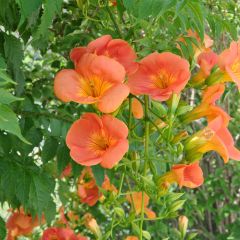
Campsis grandiflora
- Flowering time September to November
- Height at maturity 7 m

Campsis radicans Indian summer
- Flowering time July to October
- Height at maturity 4 m
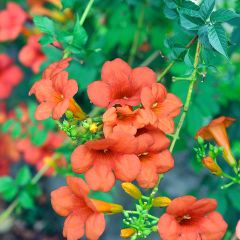
Campsis radicans x grandiflora Madame Galen
- Flowering time August to October
- Height at maturity 10 m
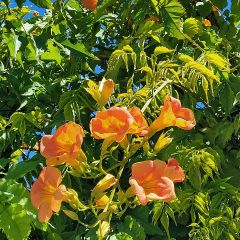
Campsis x tagliabuana Summer Jazz Gold
- Flowering time August to October
- Height at maturity 3 m
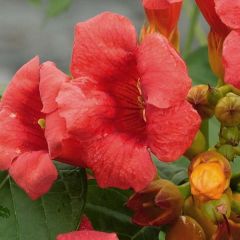
Campsis radicans Stromboli - Trumpet Vine
- Flowering time August, September
- Height at maturity 4 m
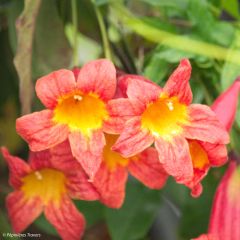
Campsis capreolata Tangerine Beauty
- Flowering time June to October
- Height at maturity 8 m

Campsis radicans Flamenco
- Flowering time September to November
- Height at maturity 8 m
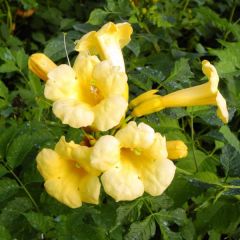
Campsis radicans Yellow Trumpet
- Flowering time August to October
- Height at maturity 6 m
Discover other Campsis - Trumpet Creeper
View all →Available in 0 sizes
Available in 0 sizes
Available in 1 sizes
Available in 2 sizes
Available in 1 sizes
Available in 3 sizes
Available in 1 sizes
Available in 1 sizes
Available in 1 sizes
Available in 2 sizes
Planting
Where to plant the Trumpet Vine?
Although it has a fairly good resistance to cold, withstanding temperatures down to -10°C on average, sometimes even lower depending on the species and growing conditions, the Trumpet Vine prefers to be planted in regions with relatively mild winters. It is a vigorous plant, but strong frosts and icy winds should be avoided. The Summer Jazz® series of trumpet vines are more cold-resistant.
In cold regions, it must be planted in a sheltered south-facing position, along a well-exposed wall or against a tree, protected from the cold and drying winter winds that can damage its flowering and cause premature bud drop. However, be careful not to plant the trumpet vine near a drainage network: its powerful root system can damage pipes.
In a sheltered position, the plant will regrow from the stump after being damaged by frost. It is well resistant to sea spray in coastal gardens.
It needs full sun to flower well. In the south of our country, it will tolerate partial shade. The Campsis radicans ‘Indian Summer’, hardy down to -15°C, is the form that thrives best in partial shade in the less sunny regions north of the Loire.
Not very demanding regarding soil type, it adapts to any good garden soil, well-drained, even calcareous, but especially not too wet: it dislikes heavy, compact, and waterlogged soils. However, it prefers a fertile and sufficiently deep soil. It likes soils that remain cool, but as it matures, it will tolerate a periodically dry soil in summer. In fertile and cool soil, its growth will be greatly enhanced, and its flowering will be very abundant.
The Trumpet Vine can be used in many ways in a mild climate garden. With a growth rate ranging from fast to slow depending on the varieties, it makes a good wall cover. It fits into all gardens, even the smallest, depending on the varieties.
When not guided on a support, it can form a beautiful bushy mass above a low wall or on a slope where it will create an original ground cover.
→ Discover the reasons why a trumpet vine does not flower!
When to plant Trumpet Vines?
Plant the Trumpet Vine in spring, from March to May, or in autumn in mild climates.
How to plant a Campsis?
- In the ground
To dress up a well-exposed wall or fence, plant a Trumpet Vine every 3 to 4 m, otherwise maintain a planting distance of 1 to 2 m from other plants. Most trumpet vines (except for Campsis radicans, which develops sufficiently strong climbing roots to allow it to climb unaided) need a trellis or stake to guide their initial growth. If your garden soil is too heavy, add gravel to the bottom of the hole.
- Dig a hole three times wider than the root ball
- With some of the excavated soil, create a small mound at the bottom of the hole to support the roots
- Make a good layer of gravel to ensure perfect drainage
- Place the plant in the centre of the hole, with the collar level with the soil
- Bring back the excavated soil mixed with potting soil to encase the roots
- Firm down with your foot
- Mulch around the base
- Water regularly until it takes root
- A trumpet vine trained as a tree
Some trumpet vines (Podranea ricasoliana) can be trained as a tree like a wisteria, which can be useful for pot cultivation.
- Train the strongest stem on a sturdy stake
- Remove secondary shoots up to the desired height to form a trunk
Pot Cultivation
Some varieties, more compact and hardy, such as the Trumpet Vine Indian Summer, and hybrid trumpet vines (Campsis x tagliabuana ‘Summer Jazz Fire’) are suitable for small spaces and large pot cultivation. Plant in a well-draining mix of leaf mould, garden soil, and coarse sand. Fertilise regularly, repot every 3 years, and regularly prune the trumpet vine to contain its growth. Keep the soil cool in summer, mulch generously in winter, or bring pots indoors to protect from severe frosts in cold regions.
→ Learn more about the cultivation of trumpet vine in pots in our advice sheet.
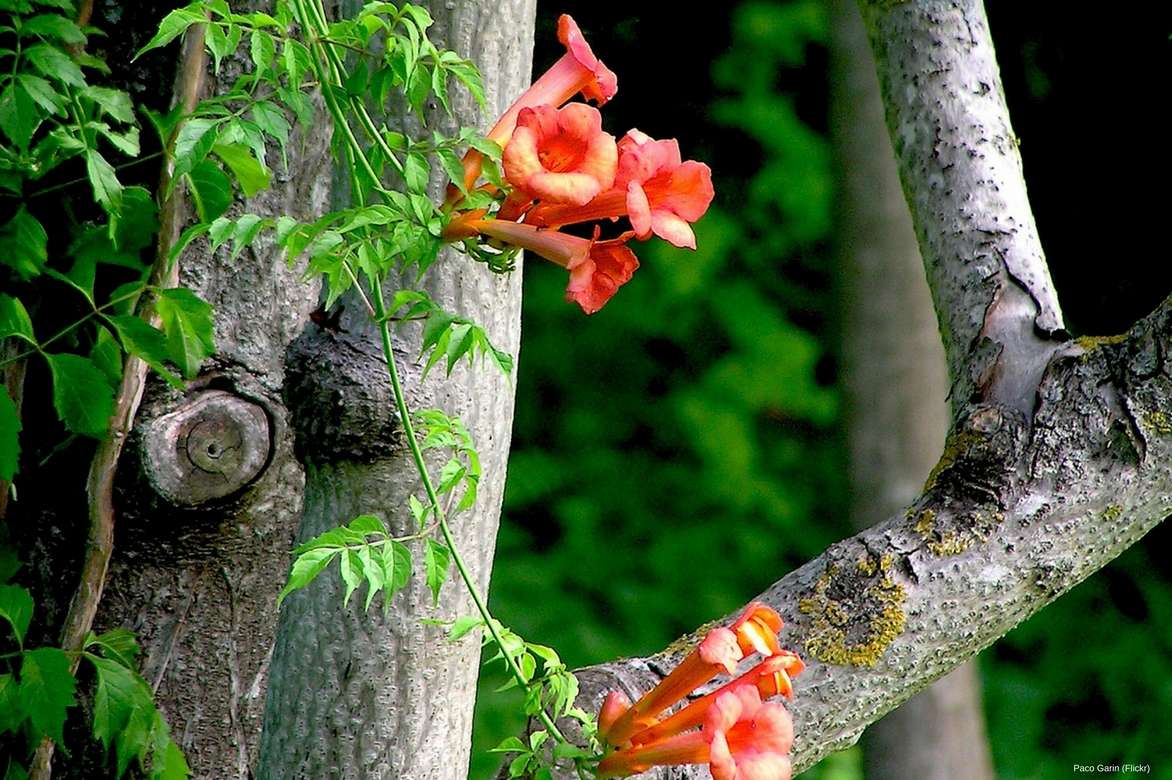
Campsis radicans
Maintenance and care
Low-maintenance, the Trumpet Creeper requires very little care, only fearing severe frosts. It simply needs to be protected from the cold during its first years of growth. This is indeed its only weakness!
Train the young shoots as they are unable to cling to their support until the plant can do so on its own.
Water regularly during the first summers.
Keep its base cool with ground-cover perennials or mulch, especially during prolonged dry spells and for the first 3 years after planting. It will tolerate drought well once established.
Renew this mulch before winter; during the first years of growth, protect the stump from severe frosts.
In spring, add a good layer of compost at the base to encourage flowering and maintain soil moisture.
Potted Trumpet Creepers need regular fertiliser and watering during the growing season. In winter, protect the pot or bring it indoors.
Repot every 3 years when the Trumpet Creeper shows signs of exhaustion.
Pruning the bignonia: when and how?
Pruning is not essential, but it can be necessary if your trumpet vine becomes invasive: it is a vigorous plant that sometimes requires containing its growth! It helps maintain a compact and balanced habit, encourages growth, and stimulates flowering. Annual pruning will also prevent the plant from becoming bare at the base.
When to prune?
Prune the trumpet vine at the end of winter, between February and March, before the vegetation resumes. In August-September, simply remove the faded shoots. The trumpet vine should not be pruned in autumn.
How to prune?
The more severe the pruning, the more vigorous and floriferous your trumpet vine will be! If the branches are dried out in their upper third, which is a normal phenomenon, it is time to prune.
- Using pruning shears, remove the dry tips damaged by frost, the crossed, thin, or dead branches at their base, keeping only the most vigorous ones
- Cut back the shoots from the previous year to 3 or 4 buds from the main stem (about 40 cm)
- Prune while leaving a few buds on each shoot
- If necessary, it can be cut back severely without issue
→ Learn more about pruning the trumpet vine with tips from Virginie, and about pruning the trumpet vine into a tree shape in our tutorial sheet. You may be overwhelmed by your trumpet vine: discover Alexandra’s tips on how to get rid of an invasive trumpet vine.
Pests and potential diseases
Trumpet Creeper is rarely diseased and exhibits good resistance. Mealybugs, aphids, red spider mites, whiteflies, and powdery mildew are its main enemies. These attacks are rarely severe.
Recognisable by the cottony white masses they leave on the leaves, mealybugs can be eliminated with a cotton ball soaked in 90°C alcohol, followed by rapeseed oil sprays to be repeated two or three times at 15-day intervals.
Soapy water sprays may be sufficient to dislodge aphids.
Against red spider mites, common in summer, spray a nettle infusion.
Trumpet creepers are often heavily visited by ants, usually without harm to the plant.
→ Learn more about diseases and pests of the trumpet creeper in our advice sheet.
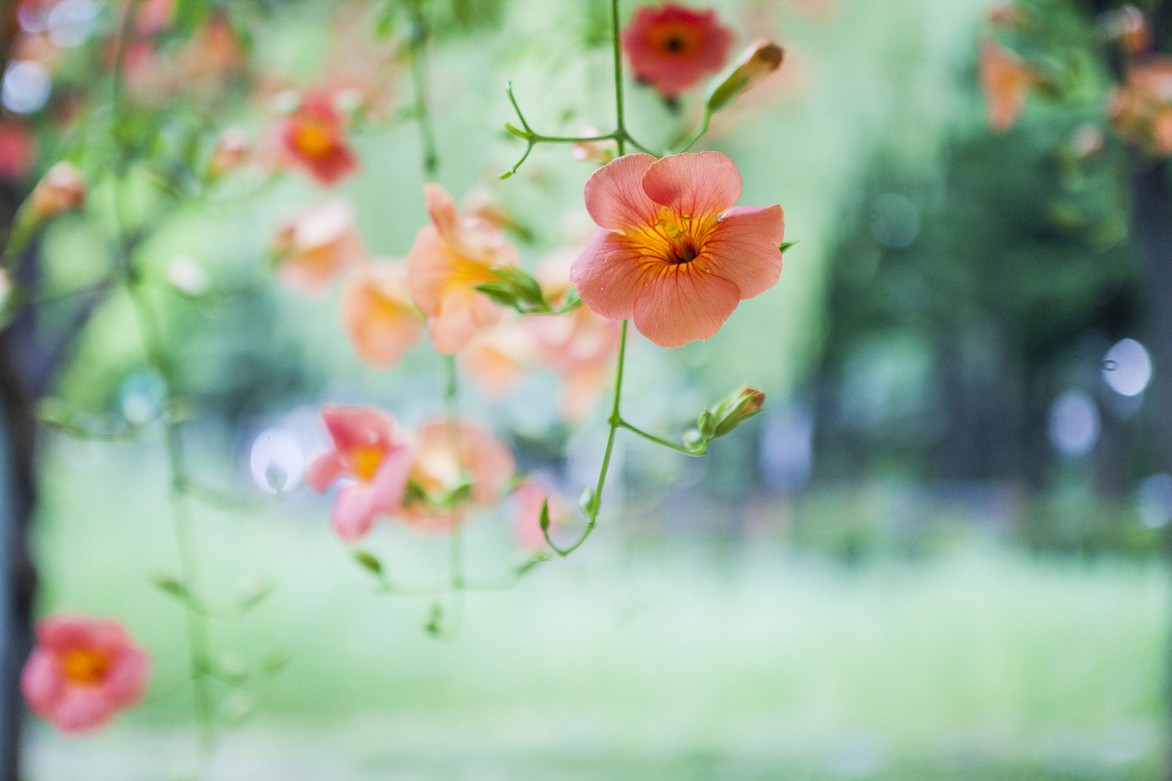
Cutting of trumpet vine: how to do it?
How to take cuttings of Trumpet Vine?
Propagation by cuttings is not straightforward for an amateur as rooting takes quite a long time.
- After flowering, take semi-woody cuttings (turning into wood) 3 to 5 cm long
- Insert them three-quarters into a light substrate (turf and river sand) that is well-draining and kept moist, spacing them 5 cm apart
- Place the tray or pot under a frame during winter
- Transplant them into the ground the following spring when they have sufficient roots
By layering
While propagation by cuttings is possible, layering in spring remains, in our opinion, the simplest method.
- Dig a furrow in the soil near the parent plant
- Choose a non-flowering stem with climbing roots that is easy to bend to the ground
- Burrow the aerial parts about twenty centimetres deep
- Raise the tip of the shoot and stake this aerial part
- Fill in the furrow and secure the layer
- Separate the layer from the parent plant when it has sufficient roots in autumn or the following spring
- Grow the layer in a pot for optimal recovery before planting in the ground
→ Learn more about propagation by cuttings of Trumpet Vine in Solenne’s tutorial
Associating the trumpet of Jericho
The bignonia is a vigorous climbing plant that thrives well when grown in isolation, adding a touch of exoticism to any support provided. In gardens with a mild climate, it can be cultivated against a wall where it will often flower more abundantly or entwine large bushes or small trees.
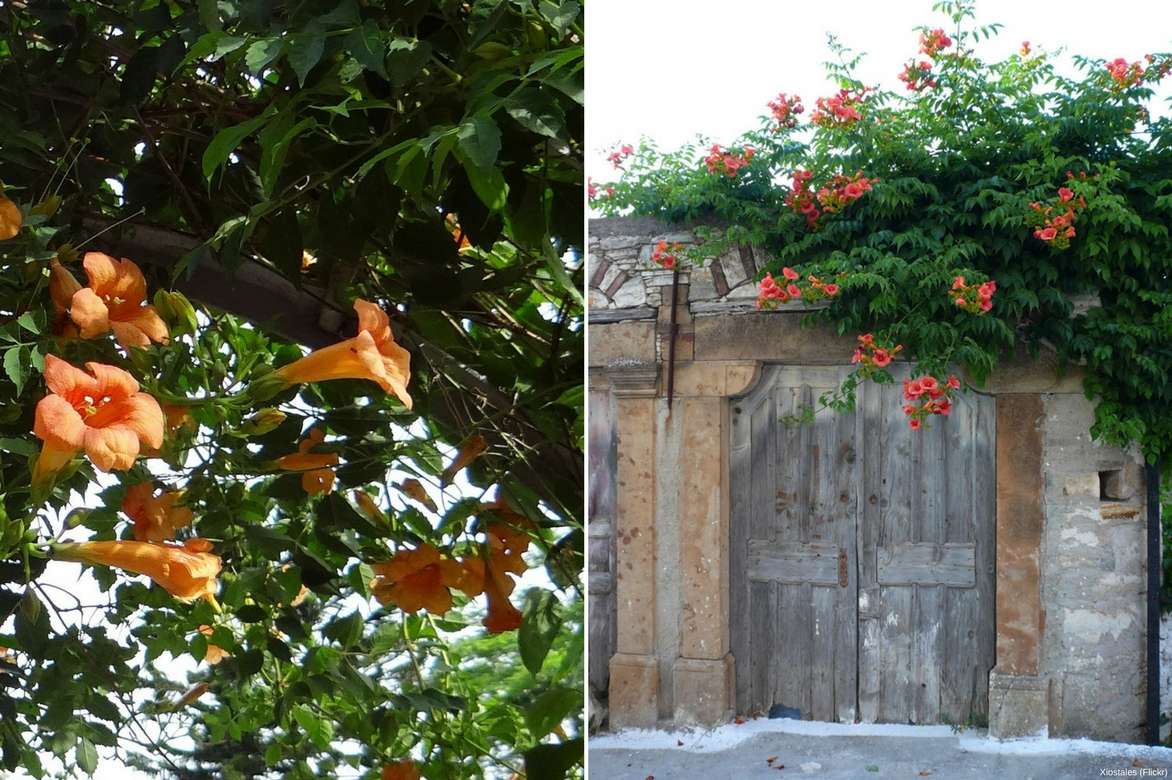
Bignonia: on a wooden arch / enhancing a stone wall.
The most compact varieties (Campsis x tagliabuana) will form an extraordinary bush in the middle of a flowerbed, becoming the focal point of a small garden.
Its flowers, usually orange-red in colour, pair well with warm hues and bronze foliage.
In more contrasting compositions, combine it with the blue flowers of Clematis viticella ‘Sunny Sky’, or Sollya heterophylla, a lovely ipomoea.
While bignonias pair well with each other, to create a vibrant scene, associate it with other original climbing plants such as Akebia quinata, Actinidia kolomikta or ornamental kiwi, and Holboellia latifolia.
It pairs effectively with chartreuse foliage, such as ivy, hops, and golden Catalpa, as well as with a Clematis garnet ‘Cardinal’ or purple vines.
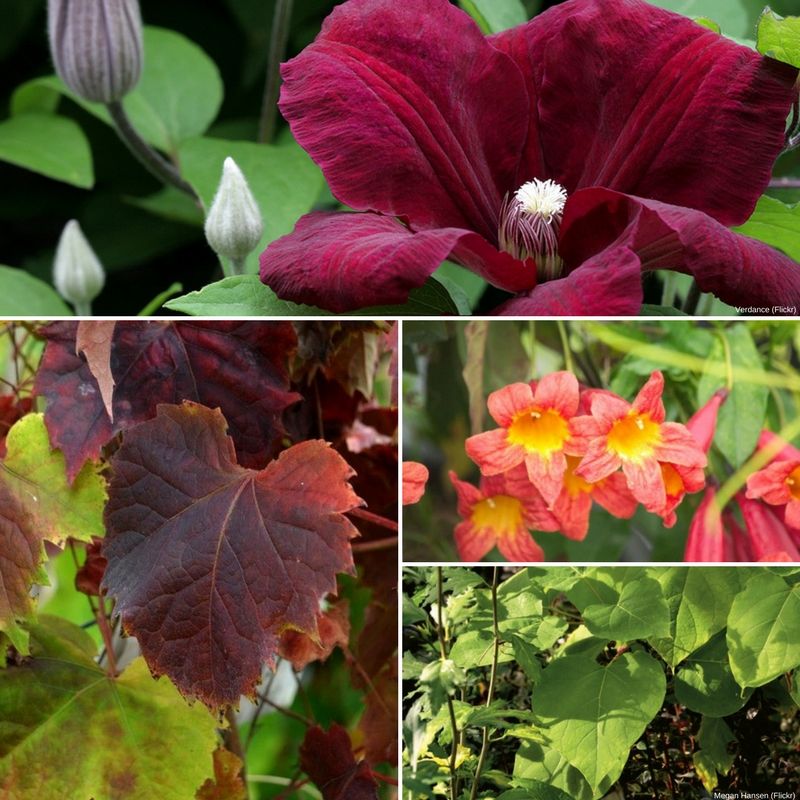
A beautiful idea for association: Clematis ‘Rouge Cardinal’ / Parthenocissus tricuspidata ‘Atropurpurea’ / Campsis capreolata ‘Tangerine Beauty’ / Catalpa bignonioides ‘Aurea’.
It will weave beautifully through an Eleagnus.
The autumn hues of a Cotinus or smoke tree will complement the colour of a late flowering Campsis radicans or Virginia bignonia.
At its base, you can plant perennials or small bushes such as shrub salvias, a Cerastostigma with small blue flowers, daylilies, gaura, asters, and euphorbias.
Useful resources
- A collection of exceptional trumpet creepers? Discover our exclusives!
- Advice sheet: Choosing a trumpet creeper
- Advice sheet: Growing a trumpet creeper in a pot
- Tutorial sheet: How to prune a trumpet creeper into a tree shape?
- Advice sheet: 5 trumpet creepers, the most beautiful varieties
- Advice sheet: 7 trumpet creepers: the sure values
- Advice sheet: 7 hardiest trumpet creepers
- Advice sheet: Which trumpet creeper to plant according to your region?
Frequently asked questions
-
Why isn't my trumpet vine flowering, and what could be the reasons?
Campsis prefers warmth and requires a very sunny position to flower well. It is possible that the exposure is not bright enough. Therefore, plant your campsis against a south-facing wall to ensure good flowering. Your soil may also be too rich in nitrogen, which encourages leaf growth at the expense of flowers. Finally, be aware that grafted specimens flower more quickly.
- Subscribe!
- Contents
































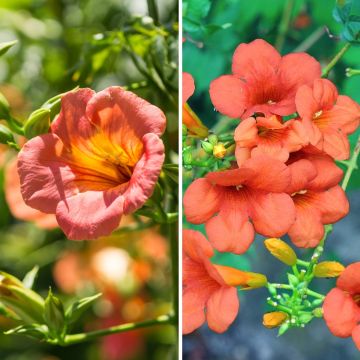

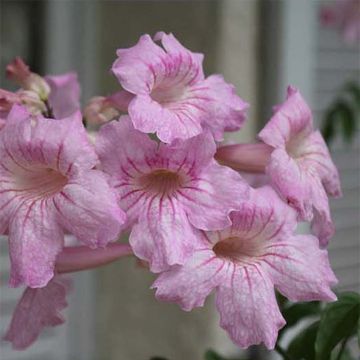

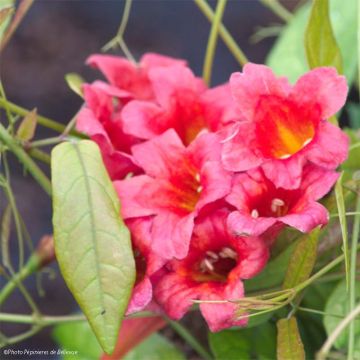

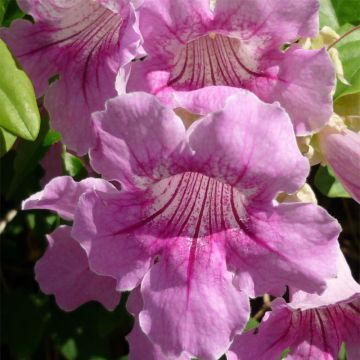

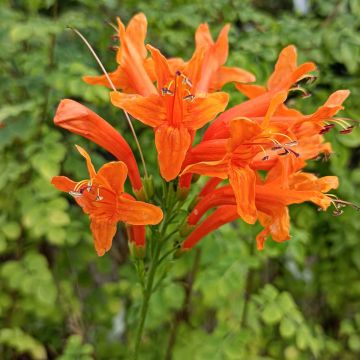

Comments